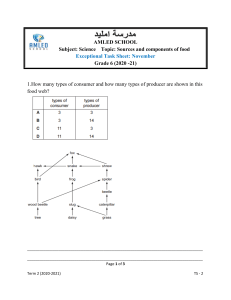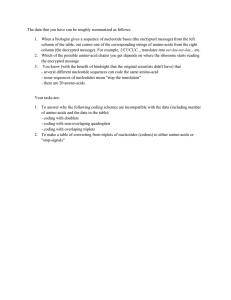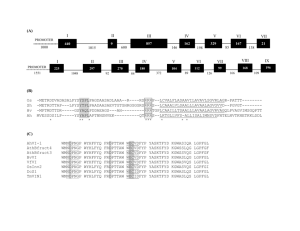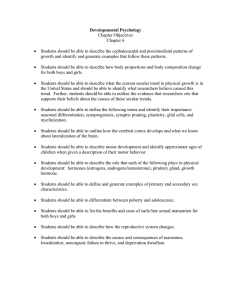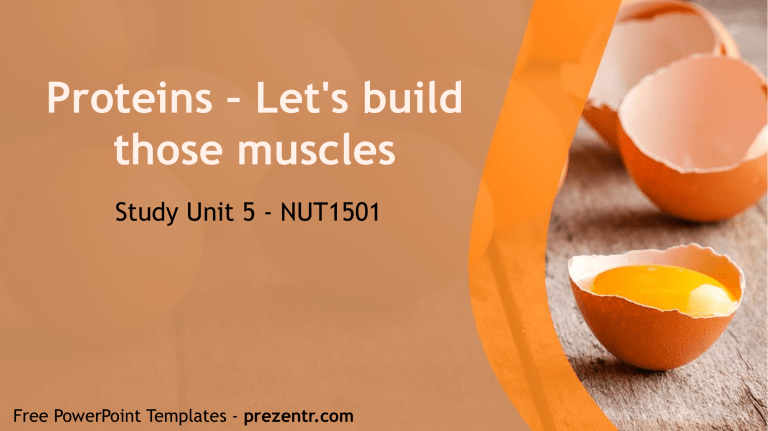
Proteins – Let's build those muscles Study Unit 5 - NUT1501 Free PowerPoint Templates - prezentr.com Main functions of protein in the body Remember 1 g of protein = 17 kJ l Source of energy l Long-term energy reserve l Growth, maintenance & repair of body tissues l Basic building block* of muscles, connective tissue, bones, blood, skin, hair, nails, hormones & enzymes * Amino acids are the smallest building blocks of protein. Three main types 1) Essential amino-acids can’t be synthesized by the body, therefore it is essential to get them from the diet. There are only 9 essential amino-acids. 1) Non-essential amino-acids can be synthesized by the body, therefore not essential to get from the diet. Refer to Figure 5.1 in the Study Guide for specific examples of each type, especially the 9 essential amino acids. 1) Conditionally essential amino-acids 2)are usually not essential (therefore they 3)can be produced by the body), but under special circumstances (such as disease) they may become essential to get from the diet. Chemical reactions & processes Refer to pg 165 – 168 in the textbook. Protein denaturation - When proteins are exposed to heat (e.g. boiled eggs) or acid they uncoil and lose their shapes. Deamination – When amino-acids are broken down, ammonia is produced which can be excreted by the kidneys. Transamination – When amino-acids are converted into other amino-acids. Nitrogen balance Starvation Critical illness Refer to pg 176 - 179 in the textbook. When glucose is formed from amino-acids Gluconeogenesis Breakdown / loss of protein stores (e.g. muscles) PEM Negative nitrogen balance (More nitrogen is used than is being supplied by the diet) Correct a negative nitrogen balance with: ↑ CHO intake + adequate fats (to spare protein) ↑ Protein intake (to replenish protein stores again) Recovery from illness Pregnant women Children Body builders Protein stores are filled / replenished Positive nitrogen balance Protein quality Refer to pg 179 - 180 in the textbook. Is the protein easily absorbed / digested or not? l l l l High quality protein Easily digested & properly absorbed E.g. red meat, chicken, fish, eggs, soya & legumes High biological value (BV): > 70 = able to meet the body's need for essential amino-acids l l l Low quality protein Poorly digested / absorbed E.g. vegetables & starches Low biological value (BV): < 70 = low in essential amino-acids, not able to meet the body's need. Complementary proteins – Two incomplete proteins eaten together to improve their protein quality e.g. legumes + grains Health effects ↓ Protein intake: - PEM (e.g. kwashiorkor, Marasmus & marasmic kwashiorkor) Remember the AMDR is 10 – 35%. Refer to pg 180 - 184 in the textbook. ↑ Protein intake: - Heart disease (especially ↑homocysteine intake) - Cancer - Obesity - Osteoporosis - Kidney stones Protein Energy Malnutrition (PEM) l l l l l l Marasmus Infancy (< 2 yrs) Develops slowly Severe nutrient deprivation / impaired absorption Severe weight loss & muscle wasting with no body fat No edema (fluid retention) Good appetite possible l l l l l l Kwashiorkor Marasmic Kwashiorkor Older infants (1-3 yrs) l Combination of Rapid onset marasmus & Inadequate protein kwashiorkor intake / infections l Often caused by both Some weight loss & malnutrition & muscle wasting, infections retention of some body l Edema of kwashiorkor fat with the wasting of Edema marasmus Loss of appetite Recommended intakes Refer to pg 184 - 187 in the textbook. “Eat dry beans, slit peas, lentils and soya regularly’ & “Meat, fish, chicken, milk and eggs can be eaten every day’ (FBDG's) Focus on: l 400–500 ml milk / dairy products per day l 2 – 3 servings of fish per week l 4 eggs per week and alternatively l < 560 g of meat per week Preferably low fat products and use fat sparingly in the preparation. [Dried beans & soya are good quality protein and can be used to substitute animal protein sources in the diet]
